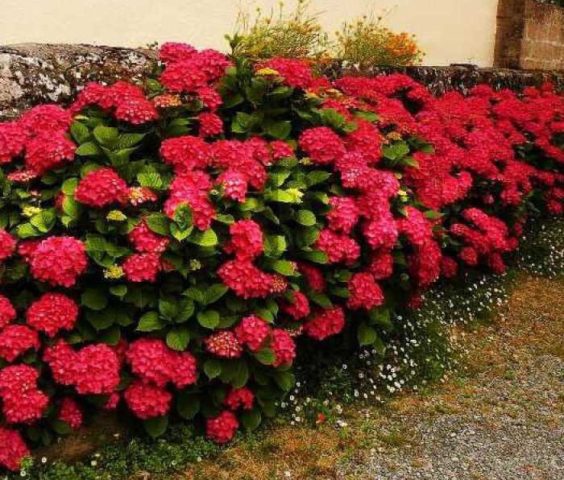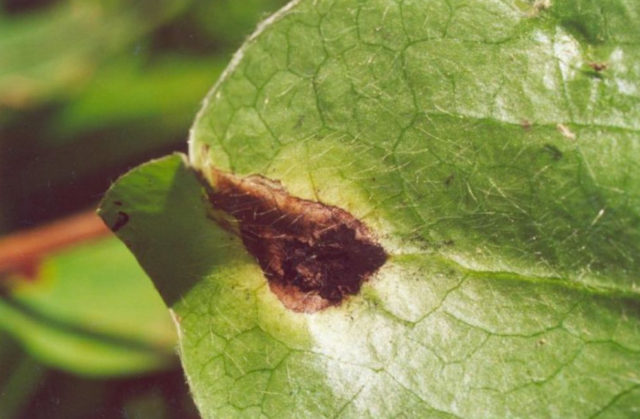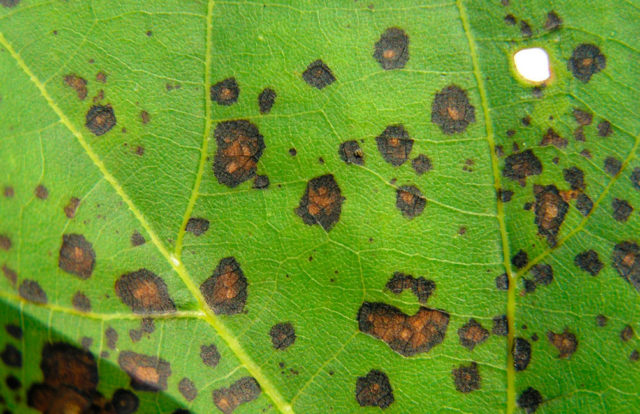Content
When choosing flowers to decorate your garden plot or the area in front of your house, you should pay attention to a plant such as Royal Red hydrangea. This colorful shrub looks great both in open ground and in large pots placed along paths or on an open veranda.
Description of hydrangea Royal Red
Large-leaved hydrangea can reach a height of up to 1.5 m. Its leaves have an oval shape, jagged edges and a rich green color. Dense foliage and lush inflorescences give the bush a ball shape.

Hydrangea can overwinter in open ground without shelter
The diameter of the Royal Red inflorescences themselves is about 15 cm. They consist of four-petaled sterile flowers of bright red color. The color of hydrangea depends on the characteristics of the soil: on neutral soils the color is lighter, even creamy, and on acidic soils it acquires a bluish tint.
Flowering begins in late July and continues until early autumn.
Hydrangea largeleaf Royal Red in landscape design
Large-leaved hydrangea Royal Red Purple is a very popular plant for creating landscape compositions.
It can be planted alone to decorate paths or small open areas. Another option is to use it to create a hedge. The bushes are tall and do not bend to the ground.

It is very important for a plant to choose the right planting location.
It also looks great in combination with other plants. Flower beds consisting of multi-colored hydrangeas of different varieties look very beautiful.

In dry autumn, you need to water the plant abundantly
Royal Red goes well with coniferous trees - juniper, thuja or blue spruce, or barberry bushes and perennial herbs.

It is very important to protect hydrangea from strong winds
Such compositions are suitable for decorating areas near a fence or along paths.
Winter hardiness of hydrangea Royal Red
It is believed that large-leaved hydrangea has average frost resistance and can easily survive the winter in open ground without the use of covering materials. The problem is that the Royal Red variety blooms on last year's shoots (flower buds are formed by autumn). Accordingly, if you do not cover the plant, then only those shoots that are covered with a layer of snow will bloom. Therefore, if gardeners want their hydrangea to please them with lush flowering, they still have to protect it from the cold.
Planting and caring for Royal Red hydrangea
As with any other garden plant, proper planting and proper care will result in a lush and beautiful hydrangea. The Royal Red variety is unpretentious in care, but it is still worth adhering to certain growing recommendations.
Selection and preparation of a landing site
The first thing you should pay attention to is choosing the right place to plant. The soil should be fertile, slightly acidic (optimal pH 5.5 to 6.0).
At the same time, it is important that water flows well into the soil - its lack during the growth period can cause deformation.
Although hydrangeas love light areas, they should not be planted in direct sunlight as they will quickly wither. A slightly shaded area works well.
Landing rules
Planting Royal Red hydrangea is done as follows:
- In the selected area, prepare a hole about 50 cm wide and up to 40 cm long. The distance between individual bushes should be about 100 cm.
- If the soil is not too fertile, then 2 weeks before planting the shoot, a substrate of fertile soil, humus and peat is placed in the hole.
- The hydrangea shoot is placed in the center of the hole and covered tightly with soil, compacting it around the plant.
- After planting, it is necessary to water generously and sprinkle with peat or sawdust.
- In the first days after planting, the young plant should be additionally protected from sunlight, covering it if necessary.
Watering and fertilizing
For the normal growth and development of hydrangea, proper care and, first of all, watering and fertilizing play an important role.
The Royal Red variety was bred in regions with high air humidity, therefore it is very moisture-loving and needs frequent watering. Each bush requires 1-2 buckets of water at a time. On hot summer days, hydrangea is irrigated once every 7 days, and during dry periods - twice a week.The water should be at room temperature. It is best to water in the morning or evening when it is not hot.
For feeding, you can use both organic and mineral fertilizers. It is especially relevant during the growth period of the Royal Red hydrangea. For this purpose, store-bought complexes containing iron and magnesium, or manure diluted in water (1 to 10) are suitable. In the fall, it would be useful to apply potassium-phosphorus fertilizers.
It is also necessary to use organic mulching, which protects the soil from overheating and weed growth. It is performed at the end of spring, filling the space around the hydrangea bush with an even layer of sawdust or peat.
Pruning hydrangea Royal Red
Due to the fact that the Royal Red variety blooms from buds on last year's shoots, pruning is done very carefully. In the spring, dead ends are cut back to the first living bud, dried inflorescences and old leaves are removed, as well as deformed or diseased branches. To avoid removing live buds, it is better to wait until the beginning of May, when they will be clearly visible.

In May-June you can cut dry branches of the plant
More complete pruning is carried out after the hydrangea reaches three years of age. At the beginning of spring, the shoots are cut by ¾, leaving at least 2 pairs of buds. Damaged branches are also removed and a bush of the desired shape is formed.
Preparing for winter
Hydrangea Royal Red, although it survives the winter in the open ground, needs protection during frosts, otherwise uncovered shoots next summer are unlikely to please with blooming inflorescences.
It is enough to sprinkle young bushes with leaves, pine needles or sawdust. Older specimens must be bent to the ground and covered with roofing felt or special material, securing the edges with stones or bricks.

The quantity and quality of inflorescences depends not only on proper care, but also on the variety of hydrangea
In spring, there is no need to rush into opening hydrangeas. It is better to wait for the end of the night frosts and only then gradually remove the protective equipment. Young Royal Red plants can be freed from leaves and sawdust closer to May, and if frost returns, sprinkle them again.
Reproduction
If you need to propagate a growing Royal Red hydrangea, you often use the method of dividing with herbaceous cuttings.
The procedure begins in the second half of summer. To do this, cuttings 10-15 cm long with several pairs of leaves are selected. It is important that the shoots do not dry out, so it is optimal to prune in the early morning, when the plant is saturated with moisture. The shoots are placed in water and the lower pair of leaves is removed, and the upper one is shortened. After this, they are placed for a couple of hours in a solution with a growth stimulator (kornevin, zircon, etc.).

Hydrangea propagates well from cuttings
Then the cuttings are transplanted into a mixture of peat and sand (2 to 1). If transplantation is successful, within a month the cuttings should take root and produce new leaves. To do this, you need to constantly ensure that the soil is well moistened.
In autumn and winter, hydrangea seedlings are sprinkled with fallen leaves, a small frame is placed over them and additionally protected with covering material.
In the spring, when the shoots have taken root and are sufficiently strong, they are transplanted into open ground.
Another way is to propagate Royal Red hydrangea by layering. It starts in early spring.To do this, carefully loosen the ground around the plant and dig furrows radiating from it about 2 cm deep. Shoots from the lower part of the flower are placed there, secured, sprinkled with soil and watered. By the end of summer they should take root.
When the shoots reach a height of 15 cm, they are hilled up, repeating every week, until the mound reaches a height of 25 cm. Then the Royal Red hydrangea seedlings are separated and dug in, and planted in the garden bed in the spring. The plant can be transplanted to a permanent place after a year.
In early spring you can divide the bush. To do this, dig it up, clean the roots and divide it into several parts. Then they are immediately planted in the ground, slightly trimming the roots and shoots of the hydrangea.
Diseases and pests
In general, the Royal Red variety is very resistant to various diseases and pest attacks. But still, in the absence of proper care, the risk of infection remains.
Hydrangea can be affected by the following diseases:
- White rot – the fungus attacks the roots, as a result of which the hydrangea begins to wither and quickly dies. You can notice it by the darkening and then whitening of the shoots. Fungicides – “Fitosporin”, “Fundanazole”, etc. - will help cope with the infection.
- Gray rot – manifested by softening of the shoots and the appearance of gray fluff on the surface. First of all, it is necessary to remove the damaged parts of the bush, and then treat it with “Pure Flower” or “Fundazol”.
- Septoria – identified by the appearance of dark spots on the leaves. Gradually they die off and the Royal Red hydrangea dies. To save it, you need to remove the affected shoots and treat it with copper sulfate.
- Powdery mildew - pale yellow spots appear on the leaves, and a gray coating appears on the reverse side. For treatment use “Fitosporin”, “Chistotsvet” or “Topaz”.
- Rust - accompanied by a red coating on the leaves and inflorescences of hydrangea. The reason may be planting too close or too much nitrogen in the soil. Copper preparations or fungicides (Topaz, Falcon, etc.) are used for treatment.
- Ring spot – a virus that causes the appearance of ring-shaped spots up to 2 cm in diameter, followed by the death of the plant. The disease is practically untreatable, so you need to be careful when choosing planting material.
In addition to various diseases, some pests also pose a danger to Royal Red hydrangea:
- Leaf aphid – feeds on cell sap and multiplies very quickly, creating numerous colonies. The development of the flower slows down, and then gradual death begins. If there are a small number of aphids, you can wash them off with water, but if there are a lot of them, you should use insecticides.
- Root nematode – appears when soil moisture is high. It can be detected by the appearance of galls on the stem. Hydrangea can be treated with Karbofos solution. If the drug does not help, all that remains is to pull out and burn the flower.
- Spider mite – the pest lives on the back of Royal Red leaves. It can be seen by small yellow spots, which are becoming more and more numerous. At the initial stage, treating with a regular soap solution can help. In a more difficult situation, you will have to resort to special drugs (“Molniya”, “Tiofos”, etc.).
- Slug – Appears in crowded areas. It feeds on hydrangea leaves. You can get rid of it using Molluscicide granules, which are laid out on the surface of the soil.
Conclusion
Hydrangea Royal Red is a colorful lush flower that will decorate any area.It goes well with other plants and looks great next to paths and fences, as well as in flower beds. It does not require special care and is resistant to various diseases and pests.
https://www.youtube.com/watch?v=lGDtOA1_HIc


















